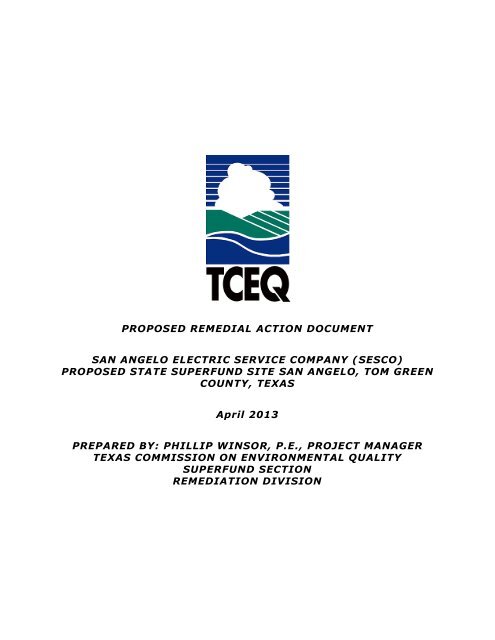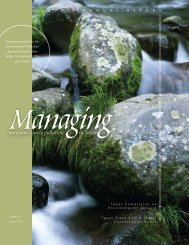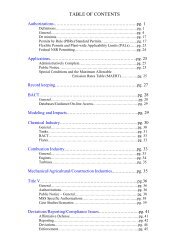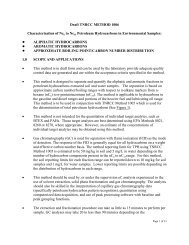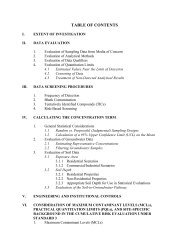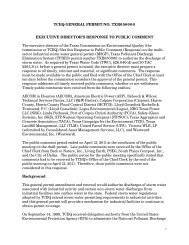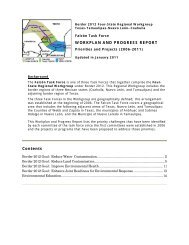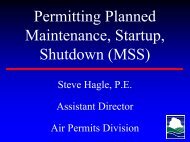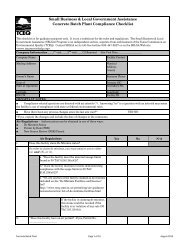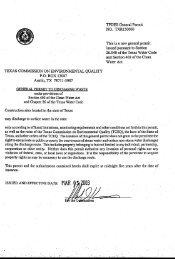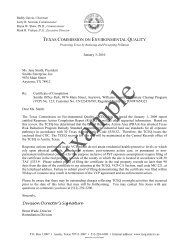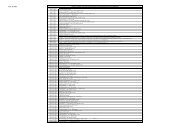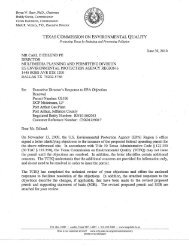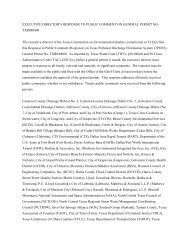Proposed Remedial Action Document - TCEQ e-Services - Texas.gov
Proposed Remedial Action Document - TCEQ e-Services - Texas.gov
Proposed Remedial Action Document - TCEQ e-Services - Texas.gov
Create successful ePaper yourself
Turn your PDF publications into a flip-book with our unique Google optimized e-Paper software.
PROPOSED REMEDIAL ACTION DOCUMENT<br />
SAN ANGELO ELECTRIC SERVICE COMPANY (SESCO)<br />
PROPOSED STATE SUPERFUND SITE SAN ANGELO, TOM GREEN<br />
COUNTY, TEXAS<br />
April 2013<br />
PREPARED BY: PHILLIP WINSOR, P.E., PROJECT MANAGER<br />
TEXAS COMMISSION ON ENVIRONMENTAL QUALITY<br />
SUPERFUND SECTION<br />
REMEDIATION DIVISION
<strong>Proposed</strong> <strong>Remedial</strong> <strong>Action</strong> <strong>Document</strong><br />
San Angelo Electric Service Company <strong>Proposed</strong> State Superfund Site<br />
TABLE OF CONTENTS<br />
I. INTRODUCTION ___________________________________________________________________________ 4<br />
II. PURPOSE ___________________________________________________________________________________ 4<br />
III. LEGAL AUTHORITY ___________________________________________________________________ 5<br />
IV. SITE HISTORY ___________________________________________________________________________ 6<br />
V. SUMMARY OF REPORTS _______________________________________________________________ 7<br />
A. HAZARD RANKING SYSTEM REPORT _____________________________________________ 7<br />
B. REMEDIAL INVESTIGATION REPORTS ___________________________________________ 7<br />
Soil: __________________________________________________________________________________ 8<br />
Groundwater: _________________________________________________________________________ 8<br />
NAPL Assessment: ____________________________________________________________________ 9<br />
Tier 2 Screening-Level Ecological Risk Assessment (SLERA): ________________________ 10<br />
C. PROTECTIVE CONCENTRATION LEVELS (PCL) DOCUMENT ____________________ 11<br />
D. REMOVAL ACTION WORK PLANS ________________________________________________ 11<br />
E. FEASIBILITY STUDY/PRESUMPTIVE REMEDY DOCUMENT (FS/PRD) ________ 12<br />
VI. DESCRIPTION OF REMEDIAL ACTION ALTERNATIVES ________________ 12<br />
A. Soils with Chlorinated VOCs above PCLs _______________________________________ 12<br />
B. Soils with PCBs above PCLs _____________________________________________________ 13<br />
C. Buried Debris with Underlying Soils Potentially Containing Metals,<br />
Chlorinated VOCs and PCBs ________________________________________________________ 13<br />
D. Groundwater with Metals Above PCLs __________________________________________ 13<br />
E. Groundwater with Chlorinated VOCs above PCLs ______________________________ 13<br />
F. Mobile NAPL in Contact with Groundwater _____________________________________ 13<br />
G. SESCO Buildings Containing PCBs ______________________________________________ 14<br />
H. Tank Farm Containment Area Facilities ________________________________________ 14<br />
I. Underground Piping ______________________________________________________________ 14<br />
VII. EVALUATION OF REMEDIAL ACTION ALTERNATIVES ________________ 14<br />
A. Soils with Chlorinated VOCs above PCLs _______________________________________ 15<br />
B. Soils with PCBs Above PCLs _____________________________________________________ 15<br />
C. Buried Debris with Underlying Soils Containing Metals, Chlorinated VOCs<br />
and PCBs _____________________________________________________________________________ 16<br />
D. Groundwater with Metals above PCLs __________________________________________ 17<br />
E. Groundwater with Chlorinated VOCs above PCLs ______________________________ 17<br />
F. Mobile NAPL in Contact with Groundwater _____________________________________ 18<br />
G. SESCO Buildings Containing PCBs ______________________________________________ 18
<strong>Proposed</strong> <strong>Remedial</strong> <strong>Action</strong> <strong>Document</strong><br />
San Angelo Electric Service Company <strong>Proposed</strong> State Superfund Site<br />
H. Tank Farm Containment Area Facilities ________________________________________ 19<br />
I. Underground Piping ______________________________________________________________ 20<br />
VIII. THE PROPOSED REMEDIAL ACTION ________________________________________ 21<br />
IX. COMMUNITY PARTICIPATION IN THE SUPERFUND PROCESS _____ 22<br />
X. REMAINING STEPS IN THE SUPERFUND PROCESS _______________________ 23<br />
XI. GLOSSARY ________________________________________________________________________________ 24<br />
TABLE OF TABLES<br />
TABLE : CLEANUP GOALS FOR SURFACE AND SUBSURFACE SOIL _________________________ 21<br />
TABLE : CLEANUP GOALS FOR GROUNDWATER ____________________________________________ 21<br />
TABLE OF FIGURES<br />
FIGURE : SITE LOCATION MAP ____________________________________________________________ 26<br />
FIGURE : SITE MAP ________________________________________________________________________ 27<br />
FIGURE : PROPOSED SOIL REMEDIAL ACTION AREAS _____________________________________ 28<br />
FIGURE : PROPOSED GROUNDWATER REMEDIAL ACTION AREAS__________________________ 29<br />
FIGURE : PROPOSED SITE-WIDE PLUME MANAGEMENT ZONE _____________________________ 30<br />
Page 3 of 30
<strong>Proposed</strong> <strong>Remedial</strong> <strong>Action</strong> <strong>Document</strong><br />
San Angelo Electric Service Company <strong>Proposed</strong> State Superfund Site<br />
I. INTRODUCTION<br />
The San Angelo Electric Service Company (SESCO) <strong>Proposed</strong> State Superfund Site (the<br />
site) is located on six acres in a mixed residential and commercial/industrial area of<br />
northeastern San Angelo, Tom Green County, at 926 Pulliam Street (see Figure 1, Site<br />
Location Map, and Figure 2, Site Map). SESCO was founded in 1932 as a motor magneto<br />
and starter repair company. Around 1946, the company transitioned its operations to<br />
building, repairing, and servicing electrical transformers. During its operations,<br />
polychlorinated biphenyls (PCBs), a component in certain transformer oils, were<br />
discovered in the soil and groundwater both on and off the SESCO property. Volatile<br />
and semivolatile organic compounds and inorganic metals, spilled during routine<br />
operations over the life of the active facility, are also chemicals of concern (COCs) at the<br />
site. SESCO ended its operations in August 2003.<br />
Currently, the site is bordered by residential properties on the west and north. Light<br />
commercial/small businesses make up the east and northeast borders. On the south<br />
side, Pulliam Street separates the site from the San Jacinto Elementary School property.<br />
The <strong>Texas</strong> Commission on Environmental Quality (<strong>TCEQ</strong>) is an agency in the State of<br />
<strong>Texas</strong> that implements many of the state laws relating to the conservation of natural<br />
resources and the protection of public health and safety and the environment. The<br />
<strong>TCEQ</strong> addresses certain sites that may constitute an imminent and substantial<br />
endangerment to public health and safety or the environment through the state<br />
Superfund program.<br />
II. PURPOSE<br />
This <strong>Proposed</strong> <strong>Remedial</strong> <strong>Action</strong> <strong>Document</strong> (PRAD) presents the proposed <strong>Remedial</strong><br />
<strong>Action</strong> (also known as the remedy) for the site, which is designed to address the<br />
contamination and provide protection of public health and safety and the environment.<br />
Words appearing in bold italics in this document are defined in Section XI,<br />
“Glossary,” of this PRAD.<br />
The purpose of this document is:<br />
<br />
<br />
<br />
<br />
to describe the actions taken by the <strong>TCEQ</strong>, the participating Potentially<br />
Responsible Parties (PRPs), and the U.S. Environmental Protection Agency<br />
(EPA) to investigate the contamination, including any mitigating actions;<br />
to describe the proposed <strong>Remedial</strong> <strong>Action</strong>;<br />
to solicit public review and comment on the proposed <strong>Remedial</strong> <strong>Action</strong>; and<br />
to provide information on how the public can comment on the proposed<br />
<strong>Remedial</strong> <strong>Action</strong>.<br />
This PRAD summarizes information that can be found in greater detail in various<br />
reports located in the site files. Relevant documents are identified and summarized in<br />
Part V, “Summary of Reports,” of this PRAD.<br />
Page 4 of 30
<strong>Proposed</strong> <strong>Remedial</strong> <strong>Action</strong> <strong>Document</strong><br />
San Angelo Electric Service Company <strong>Proposed</strong> State Superfund Site<br />
The <strong>TCEQ</strong> encourages the public to review these documents to gain a better<br />
understanding of the site; the state Superfund process; the actions taken by the <strong>TCEQ</strong>,<br />
the participating PRPs, and the EPA; and the actions proposed by the <strong>TCEQ</strong> to address<br />
the threats presented by the site.<br />
Copies of the documents summarized in this PRAD, as well as other relevant<br />
information, can be viewed at the local repository:<br />
Tom Green County Public Library<br />
33 West Beauregard Avenue<br />
San Angelo, <strong>Texas</strong> 76903<br />
(325) 655-7321<br />
or in Austin at the <strong>TCEQ</strong> Central File Room:<br />
12100 Park 35 Circle<br />
Building E, 1st Floor<br />
Austin, <strong>Texas</strong> 78753<br />
(512) 239-2900<br />
III. LEGAL AUTHORITY<br />
The investigation of the nature and extent of contamination at the site and the selection<br />
of the proposed <strong>Remedial</strong> <strong>Action</strong> is in accordance with the Solid Waste Disposal<br />
Act (codified as Chapter 361 of the <strong>Texas</strong> Health and Safety Code); Subchapter K:<br />
Hazardous Substance Facilities Assessment and Remediation rules found in Chapter<br />
335 of 30 <strong>Texas</strong> Administrative Code (T.A.C.) (Subchapter K); the <strong>Texas</strong> Risk<br />
Reduction Program (TRRP) rules found in Chapter 350 of 30 T.A.C.<br />
While the Subchapter K rules are specific to the state Superfund process, the TRRP rules<br />
are a comprehensive program for addressing chemical contamination and apply to<br />
many different types of corrective action administered by the <strong>TCEQ</strong>. The TRRP rules<br />
establish procedures for determining the concentration of COCs to which a person or<br />
other environmental receptor can be exposed without unacceptable risk of harm. These<br />
acceptable concentration levels are called Protective Concentration Levels (PCLs).<br />
A PCL can be thought of as the “cleanup level” for contamination.<br />
A three-tiered approach may be used under the TRRP rules to calculate the PCLs for a<br />
site. The tiers represent increasing levels of evaluation where site-specific information is<br />
factored into the process. Tier 1 uses conservative, generic equations and input factors<br />
that do not account for site-specific factors; Tier 2 allows for the use of site-specific<br />
information, but requires the use of PCL equations provided by the <strong>TCEQ</strong>; and Tier 3<br />
allows for more detailed and complex evaluations so that PCLs are appropriate for<br />
specific site conditions. The PCLs for arsenic and barium were developed under Tier 2.<br />
All other PCLs for the site were developed under Tier 1.<br />
The land use classification is critical under all three of the tiers. Under the TRRP rules,<br />
land can be classified as either residential or commercial/industrial. Remediation to<br />
Page 5 of 30
<strong>Proposed</strong> <strong>Remedial</strong> <strong>Action</strong> <strong>Document</strong><br />
San Angelo Electric Service Company <strong>Proposed</strong> State Superfund Site<br />
residential standards assumes that a site may be occupied by children and therefore is<br />
applicable not only to strictly residential land, but also to playgrounds, schools, daycare<br />
centers, and similar land uses. Remediation to commercial/industrial standards<br />
assumes that a site will not be regularly occupied by children and is protective of<br />
persons who may occupy the site as workers. Sites remediated to commercial/industrial<br />
standards cannot be used for residential-type activities unless further controls are<br />
implemented to make the site safe for that use. The <strong>TCEQ</strong> has determined that a<br />
commercial/industrial land use classification is appropriate for the site.<br />
The TRRP rules allow risks posed by the presence of contamination above a PCL to be<br />
managed by any combination of the following: 1) removal or decontamination of<br />
contaminated media; 2) physical controls, such as containment cells and caps, which<br />
limit exposure to the contaminated media; or 3) institutional controls, such as<br />
restrictive covenants or deed notices, to inform future owners and the public of<br />
contamination on the property in an effort to limit exposure to the contaminated media.<br />
These remedy standards under the TRRP rules are divided into two main categories:<br />
Remedy Standard A and Remedy Standard B. To meet Remedy Standard A<br />
requirements, the contaminated media must be removed and/or decontaminated such<br />
that physical controls and, in most cases, institutional controls are not necessary to<br />
protect human and ecological receptors. To meet the requirements of Remedy Standard<br />
B, however, physical controls and institutional controls may be relied on to protect<br />
human and ecological receptors from levels of contamination exceeding PCLs. These<br />
standards are described in detail in 30 T.A.C. Sections 350.32 and 350.33. The proposed<br />
remedy at the site meets the criteria established for Remedy Standard B.<br />
IV. SITE HISTORY<br />
SESCO operated as a motor magneto and starter repair company from approximately<br />
1932 to 1946. Around 1946, it transitioned to building, repairing, and servicing electrical<br />
transformers. It ceased operation in 2003. During its operations, polychlorinated<br />
biphenyls (PCBs), a component in certain transformer oils, were discovered in the soil<br />
and groundwater both on and off the SESCO property. Volatile and semivolatile organic<br />
compounds and inorganic metals, spilled during routine operations over the life of the<br />
active facility, are also COCs at the site.<br />
Prior to filing bankruptcy and ceasing operations in 2003, SESCO performed limited<br />
investigation and remediation activities at the site. These activities were conducted<br />
pursuant to a 1994 Agreed Administrative Order with the <strong>Texas</strong> Natural Resource<br />
Conservation Commission (predecessor to the <strong>TCEQ</strong>) and a 2002 district court<br />
injunction.<br />
Additional discharges from the facility in 2003 necessitated the involvement of both the<br />
<strong>TCEQ</strong> Emergency Response Team and the <strong>TCEQ</strong> Remediation Division. Between March<br />
2003 and January 2004, the <strong>TCEQ</strong> conducted a number of actions to protect human<br />
health and the environment, including:<br />
<br />
excavation and removal of 2,000 cubic yards of contaminated soil from the<br />
SESCO facility;<br />
Page 6 of 30
<strong>Proposed</strong> <strong>Remedial</strong> <strong>Action</strong> <strong>Document</strong><br />
San Angelo Electric Service Company <strong>Proposed</strong> State Superfund Site<br />
<br />
<br />
<br />
excavation and removal of contaminated soil from two residences, an alleyway,<br />
and an elementary school soccer field;<br />
construction of a three-foot high berm around portions of the perimeter of<br />
SESCO East to prevent migration of contamination through rainwater running<br />
off the property; and<br />
continued operation of the groundwater recovery system to prevent the spread of<br />
contaminated groundwater.<br />
In 2003, the EPA investigated areas adjacent or near (off-property) the SESCO property<br />
and tested stored transformers for PCBs.<br />
In late 2004, a group of PRPs known as the SESCO Site Working Group (SSWG) took<br />
over interim management of the site, including site security, operation of the<br />
groundwater recovery system, and implementation of a groundwater monitoring<br />
program. An Agreed Administrative Order <strong>gov</strong>erning the conduct of a <strong>Remedial</strong><br />
Investigation (RI) and Feasibility Study (FS), removal actions, and operations and<br />
maintenance (O&M) activities at the site was issued on September 22, 2006. The RI was<br />
completed when <strong>TCEQ</strong> approved the final phase RI report on April 15, 2011. The FS was<br />
completed when <strong>TCEQ</strong> approved the final Feasibility Study/Presumptive Remedy<br />
<strong>Document</strong> on September 17, 2012.<br />
V. SUMMARY OF REPORTS<br />
A. HAZARD RANKING SYSTEM REPORT<br />
The Hazard Ranking System (HRS) is a numerically-based screening system that<br />
uses information from initial, limited investigations to assess whether a site qualifies for<br />
the state or federal Superfund program. Sites scoring 28.5 or greater may qualify for the<br />
federal Superfund program, while sites scoring 5 or greater may qualify for the state<br />
Superfund program. The HRS scoring for the site was prepared by the <strong>TCEQ</strong> in<br />
December 2005 and is presented in the report titled “HRS <strong>Document</strong>ation Record for<br />
San Angelo Electric Service Company (SESCO) San Angelo, <strong>Texas</strong>.” The site earned a<br />
score of 12.64. The <strong>TCEQ</strong> proposed to list the site on the State Registry of Superfund<br />
Sites and published notice of its intent in the <strong>Texas</strong> Register on December 2, 2005.<br />
B. REMEDIAL INVESTIGATION REPORTS<br />
The <strong>Remedial</strong> Investigation (RI) includes sample collection, laboratory analysis,<br />
and interpretation of collected data for the purpose of determining the nature and<br />
extent of contamination associated with the site. The Phase I RI Technical<br />
Memorandum, dated October 2008, and Addendum, dated May 2009, includes a<br />
summary of the initial RI activities conducted at the site. The Phase II RI Technical<br />
Memorandum, dated February 28, 2011, includes the Phase II RI Report, the Protective<br />
Concentration Levels (PCL) <strong>Document</strong>, and the Tier 2 Site Screening Level Ecological<br />
Risk Assessment (SLERA). The following provides a summary of the RI activities<br />
completed at the site.<br />
Page 7 of 30
<strong>Proposed</strong> <strong>Remedial</strong> <strong>Action</strong> <strong>Document</strong><br />
San Angelo Electric Service Company <strong>Proposed</strong> State Superfund Site<br />
Soil:<br />
The RI activities included the collection of soil samples. The purpose of the soil<br />
sampling activities was to determine the horizontal and vertical extent of soil<br />
contamination exceeding the PCLs. Soil investigation activities were performed during<br />
multiple separate field sampling events.<br />
Soil boring locations on the SESCO property (on-property) were chosen based on a need<br />
to determine the boundaries of the impacted soils exceeding commercial/industrial<br />
PCLs for PCBs and volatile organic compounds (VOCs) [tetrachloroethylene (PCE) and<br />
trichloroethylene (TCE)]. Off-property soil boring locations were chosen based on a<br />
need to determine the boundaries of the impacted soils exceeding residential PCLs for<br />
PCBs, VOCs, and semivolatile organic compounds (SVOCs).<br />
COCs in on-property soils that were detected in excess of the applicable PCLs are<br />
present in localized, laterally discontinuous areas. The distribution of COCs in surface<br />
soils appears to represent relatively small surface spills or releases as opposed to<br />
releases that would result in widespread soil impacts. The critical PCL is defined as the<br />
lowest protective concentration level for a COC within a source medium such as soil or<br />
groundwater. A discussion of critical PCLs is presented below in Subsection C.<br />
Protective Concentration Levels (PCL) <strong>Document</strong>.<br />
There are six on-property areas where PCBs have been delineated over the critical PCL<br />
of 7.7 milligrams per kilogram (mg/kg) for industrial/commercial properties (see Figure<br />
3, <strong>Remedial</strong> <strong>Action</strong> Areas Based on Soil PCLE Zones and Buried Debris). Three of these<br />
areas are located on SESCO West and three are located on SESCO East. Typically, the<br />
PCB concentrations decrease with depth. Except for one sample location on SESCO<br />
West, there are no on-property sample locations with PCBs detected above the critical<br />
PCL at a depth below 2.5 feet.<br />
PCE and TCE were detected above their critical PCLs in areas sampled beneath the<br />
former Untanking Building on SESCO West. Soil intervals representing the highest VOC<br />
concentrations were resampled and analyzed using the Synthetic Precipitation Leaching<br />
Procedure (SPLP) to assess the chemical concentrations expected to leach from the soil<br />
to groundwater. The results from the SPLP were below the groundwater critical PCLs for<br />
PCE and TCE, indicating the concentrations of these chemicals in the soil are not<br />
expected to contaminate groundwater.<br />
The RI activities identified several areas adjacent to the SESCO property where soils<br />
containing PCBs in excess of the critical PCL were present. The soils exceeding the<br />
critical PCL from those off-property areas were removed during the removal activities<br />
that are summarized below.<br />
Groundwater:<br />
There are three Groundwater Bearing Units (GWBU) that exist beneath the site: the<br />
alluvium, the Leona Formation, and the Choza Formation. The alluvium ranges in<br />
depths between 3 to 23 feet below ground surface and includes the surface soils and<br />
Page 8 of 30
<strong>Proposed</strong> <strong>Remedial</strong> <strong>Action</strong> <strong>Document</strong><br />
San Angelo Electric Service Company <strong>Proposed</strong> State Superfund Site<br />
subsurface soils made up of sands, silty clays, and gravel. The underlying Leona<br />
Formation ranges in depths between 5 and 30 feet below the alluvium and includes<br />
consolidated sands, clays, and gravels. The Choza Formation lies below the Leona and is<br />
approximately 30 to 35 feet below ground surface with depths up to 75 feet below<br />
ground surface. The depth to the base of the Choza is unknown at this time.<br />
Sampling of groundwater during the RI indicated that there were no COCs present<br />
above PCLs in the Choza Formation. Mixed-phase Non-aqueous phase liquid<br />
(NAPL) was present in both alluvium and Leona Formation wells, as discussed below<br />
under NAPL Assessment. COCs detected above PCLs in the Leona Formation, as<br />
reported in the Phase I RI Technical Memorandum, include arsenic, barium, benzene,<br />
vinyl chloride, and PCBs (see Figure 4, <strong>Remedial</strong> <strong>Action</strong> Areas Based on Groundwater<br />
PCLE Zones and NAPL Presence). The Phase II RI included the assessment of<br />
groundwater in the Leona Formation beneath SESCO West and East and adjacent offproperty<br />
areas. The Leona Formation groundwater was characterized to determine the<br />
nature and extent of COC-impacted groundwater above PCLs detected during the Phase<br />
I RI.<br />
The Phase II RI groundwater assessment of the alluvium and Leona Formation included<br />
the following activities:<br />
<br />
<br />
<br />
<br />
<br />
quarterly (first year) and semi-annual (second year) groundwater monitoring;<br />
the installation of three additional monitoring wells in the Leona Formation to<br />
delineate COCs;<br />
the installation of three additional monitoring wells to assess NAPL southwest of<br />
SESCO West;<br />
the installation of an additional monitoring well in the alluvium on SESCO West<br />
to further delineate NAPL; and<br />
assessment of groundwater and NAPL levels in the alluvium and Leona<br />
Formation.<br />
The groundwater monitoring results indicate that arsenic, barium, vinyl chloride, and<br />
PCBs currently exceed their respective critical PCLs for groundwater (Figure 4). Only<br />
arsenic and vinyl chloride have PCL exceedances that extend beyond the SESCO<br />
property. The off-property PCL exceedance of arsenic occurs south of SESCO West at<br />
MW-10 and MW-21. Vinyl chloride exceeds the critical PCL for groundwater in one area<br />
located on SESCO West. The off-property PCL exceedance zone for vinyl chloride is just<br />
north of the former Untanking Building on SESCO West and extends north to the<br />
southern side of Upton Street just a few feet north of the SESCO property boundary.<br />
MW-56, which is located on the north side of Upton Street, bounds the upgradient side<br />
of the vinyl chloride exceedance zone.<br />
NAPL Assessment:<br />
The presence of mixed-phase NAPL (PCBs, VOCs, SVOCs, and metals) in groundwater<br />
beneath the site appears to correlate with the areas where the handling of transformer<br />
oils occurred at the site. These areas include the Oil Plant and the Untanking Building.<br />
Page 9 of 30
<strong>Proposed</strong> <strong>Remedial</strong> <strong>Action</strong> <strong>Document</strong><br />
San Angelo Electric Service Company <strong>Proposed</strong> State Superfund Site<br />
Oil was drained from transformers and placed in drums or tanks near the Untanking<br />
Building. The oil was then pumped from the drums or tanks to the Oil Plant.<br />
NAPL is present in Leona Formation monitoring wells at several locations across SESCO<br />
West. Figure 4 shows the approximate boundaries of areas currently containing NAPL.<br />
This figure indicates that NAPL is not continuous across the site. Discontinuous areas of<br />
NAPL in the Leona Formation are present in the central and southern areas of SESCO<br />
West. NAPL has not been detected beneath SESCO East. Measured thickness of NAPL in<br />
Leona Formation wells typically vary from a few tenths of a foot to a foot or more.<br />
Generally, NAPL thickness measurements in the Leona Formation wells appear to be<br />
decreasing compared to historical data, in particular in the wells equipped with<br />
skimmer pumps such as MW-8 and MW-14. NAPL thicknesses in the alluvium wells<br />
generally appear stable as these shallow wells do not contain recovery pumps and NAPL<br />
is removed by quarterly hand-bailing. These wells generally do not produce sufficient<br />
water to support skimmer pump technologies.<br />
NAPL at the SESCO site falls under two response triggers in accordance with <strong>TCEQ</strong><br />
Regulatory Guidance RG-366/TRRP-32: Risk-Based NAPL Management.<br />
<br />
<br />
Mobile NAPL Zone: Variable NAPL thickness is measured in the groundwater<br />
wells.<br />
NAPL in contact with groundwater: NAPL is in contact with Class 2 groundwater<br />
of the Leona Formation and perched groundwater within the alluvium.<br />
Tier 2 Screening-Level Ecological Risk Assessment (SLERA):<br />
Based on the findings of the Phase I RI Technical Memorandum, a Tier 2 SLERA was<br />
performed for the site. The Tier 2 SLERA included the following sampling activities:<br />
sediment sampling in the Concho River and soil and invertebrate sampling in the lower<br />
portion of the East Angelo Draw to assess the potential impact of PCBs in these areas.<br />
The 27 sediment sampling locations resulted in the analysis of 60 samples for PCBs.<br />
Invertebrate and related surface soil samples were collected at six locations in the lower<br />
East Angelo Draw and analyzed for PCBs.<br />
The Tier 2 SLERA was performed according to <strong>TCEQ</strong> Ecological Risk Assessment (ERA)<br />
guidance. The Tier 2 SLERA used several lines of evidence to determine whether PCBs<br />
(specifically Aroclor 1260) will adversely affect receptors utilizing the habitats. The<br />
results of the Tier 2 SLERA indicate that ecological receptors will not be adversely<br />
affected by PCBs in soil and sediment in these habitats.<br />
The potential for sediment in the Concho River to adversely impact human health was<br />
also evaluated. The results of this evaluation indicate that human contact with Concho<br />
River water or sediment or ingestion of fish from the river does not pose adverse risk to<br />
human health.<br />
Page 10 of 30
<strong>Proposed</strong> <strong>Remedial</strong> <strong>Action</strong> <strong>Document</strong><br />
San Angelo Electric Service Company <strong>Proposed</strong> State Superfund Site<br />
C. PROTECTIVE CONCENTRATION LEVELS (PCL) DOCUMENT<br />
A PCL <strong>Document</strong> was prepared in February 2011 and submitted as Appendix 1 of the<br />
Phase II RI Report. The objective of the PCL <strong>Document</strong> was to demonstrate how PCLs<br />
and critical PCLs were selected for each site-specific COC for complete and reasonably<br />
anticipated to be complete exposure pathways. A critical PCL is the lowest PCL for a<br />
COC within a source medium determined from all of the applicable human health<br />
exposure pathways as described in 30 T.A.C. Section 350.71 and, when necessary, PCLs<br />
for applicable ecological exposure pathways as required in 30 T.A.C. Section 350.77.<br />
Site-specific data including land use, source size area, and groundwater and soil<br />
classification were used for the selection of appropriate assessment levels and critical<br />
PCLs. Also, a Tier 2 SLERA and a Technical Memorandum for the development of a<br />
sediment PCL for PCBs were completed as part of the Phase II RI. Land use for the<br />
SESCO property was selected as commercial/industrial following the public meeting<br />
held in January 2006 in San Angelo, <strong>Texas</strong>. Surrounding non-SESCO properties were<br />
classified as residential.<br />
The source area size for soils is 0.5 acre because COCs in surface and subsurface soils<br />
above their respective PCLs are present only in localized and laterally discontinuous<br />
areas.<br />
Analytical data collected during the Phase I and II RIs and groundwater monitoring<br />
events were compared to TRRP Tier 1 PCLs applicable for the source area size and land<br />
use. Based on this evaluation, concentrations of COCs found in surface and subsurface<br />
soil samples from the SESCO property and both on-property and off-property shallow<br />
groundwater exceed applicable PCLs.<br />
D. REMOVAL ACTION WORK PLANS<br />
During the time that the Phase II RI was in progress at the site, several removal actions<br />
were completed. These removal actions were addressed in the following Removal <strong>Action</strong><br />
Work Plans (RAWPs):<br />
<br />
<br />
<br />
<br />
<br />
Removal <strong>Action</strong> Work Plan No. 1: Off-Site Soils - Debris Areas and Isolated Areas<br />
Removal, dated November 9, 2009 (RAWP-1);<br />
Removal <strong>Action</strong> Work Plan No. 1, Addendum 1: Off-Site Soils - Debris Areas and<br />
Isolated Areas Removal, dated December 24, 2009 (RAWP-1 Addendum 1);<br />
Removal <strong>Action</strong> Work Plan No. 2: Removal of Off-Site Soils - TxDOT/Railroad<br />
Right-of-way (ROW), dated June 23, 2010 (RAWP-2);<br />
Removal <strong>Action</strong> Work Plan No. 3: Untanking Building Demolition, dated June<br />
22, 2010 (RAWP 3);<br />
Removal <strong>Action</strong> Work Plan No. 3, Addendum 1: Untanking Building Demolition,<br />
Underground Storage Tank (UST) Removal, dated October 1, 2010 (RAWP-3<br />
Addendum 1); and<br />
Page 11 of 30
<strong>Proposed</strong> <strong>Remedial</strong> <strong>Action</strong> <strong>Document</strong><br />
San Angelo Electric Service Company <strong>Proposed</strong> State Superfund Site<br />
<br />
Removal <strong>Action</strong> Work Plan No. 4: Removal of Off-Site Soils - Pope Tarver Ravine,<br />
dated July 22, 2011, as updated in a response to <strong>TCEQ</strong> comments letter dated<br />
September 21, 2011.<br />
The removal actions conducted under RAWP-1, RAWP-1 Addendum 1, RAWP-2, and<br />
RAWP-4 were performed to protect human health or the environment. These removal<br />
actions were conducted in order to remove and properly dispose of contaminated offproperty<br />
soils and debris located in areas that were accessible to the public.<br />
The removal actions conducted under RAWP-3 and RAWP-3 Addendum 1 were<br />
conducted to facilitate the RI, as the Untanking Building and slab were located above a<br />
suspected source area that needed additional delineation. It was suspected that there<br />
might be a tank under the concrete slab of the Untanking Building which could be<br />
serving as a source of the NAPL.<br />
E. FEASIBILITY STUDY/PRESUMPTIVE REMEDY DOCUMENT (FS/PRD)<br />
The FS/PRD for the SESCO site, dated July 31, 2012, presented an evaluation of<br />
potential remedial alternatives to address the COCs in the site soils and groundwater.<br />
That evaluation is summarized in the following section of this PRAD.<br />
VI. DESCRIPTION OF REMEDIAL ACTION ALTERNATIVES<br />
In accordance with 30 T.A.C. Section 335.348(l) and the requirements of Section<br />
361.193 of the Solid Waste Disposal Act, the <strong>TCEQ</strong> selects the <strong>Remedial</strong> <strong>Action</strong><br />
for a site by determining which remedial alternative is “the lowest cost alternative which<br />
is technologically feasible and reliable, effectively mitigates and minimizes damage to<br />
the environment, and provides adequate protection of the public health and safety and<br />
the environment.”<br />
In the FS/PRD, several remedial alternatives and their estimated costs for cleaning up<br />
the soil and groundwater at the site were evaluated and are listed below:<br />
A. Soils with Chlorinated VOCs above PCLs<br />
Alternative 1 - In-situ Soil Vapor Extraction/Bioventing; no costs provided because<br />
infeasible<br />
Alternative 2 - Containment using Slurry Wall; $109,000 1 st year/$25,000 each<br />
additional year<br />
Alternative 3 - Excavation of Soils with Thermal Treatment; $1,066,000<br />
Alternative 4 - Excavation with Off-Site Disposal; $105,000<br />
Page 12 of 30
<strong>Proposed</strong> <strong>Remedial</strong> <strong>Action</strong> <strong>Document</strong><br />
San Angelo Electric Service Company <strong>Proposed</strong> State Superfund Site<br />
B. Soils with PCBs above PCLs<br />
Alternative 1 - Excavation of Soils with Off-Site Disposal; $618,000<br />
Alternative 2 - Containment Using Slurry Wall; $432,000 1 st year/$50,000 each<br />
additional year<br />
Alternative 3 - Excavation of Soils with Thermal Treatment; $1,276,000<br />
C. Buried Debris with Underlying Soils Potentially Containing Metals,<br />
Chlorinated VOCs and PCBs<br />
Alternative 1 - Excavation with Off-Site Disposal; $32,456<br />
Alternative 2 - Containment Using Slurry Wall; $38,000 1 st year/$2,000 each additional<br />
year<br />
Alternative 3 - Excavation with Thermal Treatment; $115,000<br />
D. Groundwater with Metals Above PCLs<br />
Alternative 1 - Control and Attenuation within a Plume Management Zone (PMZ);<br />
$71,000 1 st year/$31,100 each additional year<br />
Alternative 2 - Extraction and Treatment; No costs provided because infeasible<br />
Alternative 3 - In-situ Chemical Precipitation; No costs provided because infeasible<br />
E. Groundwater with Chlorinated VOCs above PCLs<br />
Alternative 1 - Control and Attenuation within a Plume Management Zone (PMZ);<br />
$45,500 1 st year/$21,450 each additional year<br />
Alternative 2 - In-situ Bioremediation; No costs provided because infeasible<br />
Alternative 3 - Extraction and Treatment; No costs provided because infeasible<br />
Alternative 4 - In-Situ Chemical Oxidation; - $410,000<br />
F. Mobile NAPL in Contact with Groundwater<br />
Alternative 1 - Floating NAPL Extraction to Extent Practical with Control and<br />
Attenuation within a PMZ; $72,000 1 st year/$72,000 each additional year<br />
Page 13 of 30
<strong>Proposed</strong> <strong>Remedial</strong> <strong>Action</strong> <strong>Document</strong><br />
San Angelo Electric Service Company <strong>Proposed</strong> State Superfund Site<br />
Alternative 2 - Shallow Liquid-Only Extraction with Carbon Treatment; $126,000 1 st<br />
year, $126,000 each additional year<br />
Alternative 3 - Dual Pump Liquid Extraction; No costs provided because infeasible<br />
G. SESCO Buildings Containing PCBs<br />
Alternative 1 - No <strong>Action</strong>; $0.00<br />
Alternative 2 - Decontamination/Encapsulation of PCB-Impacted Areas; No costs<br />
provided because infeasible<br />
Alternative 3 - Demolition of the Buildings with Off-Site disposal; $722,250<br />
H. Tank Farm Containment Area Facilities<br />
When the Groundwater Treatment System is permanently taken out of service,<br />
appropriate characterization of the tank farm containment area will be performed.<br />
Characterization will include collection of soil samples from below the containment area<br />
slab and wipe sampling and analysis of the walls and ceilings of the steel storage shed<br />
buildings and the inside walls of the tanks that were used to hold liquids associated with<br />
the Groundwater Treatment System operation. All samples will be analyzed for PCBs.<br />
Alternative 1 - After characterization, demolish the treatment system components and<br />
dispose of at an appropriate landfill; clean out tanks and wipe test them for PCBs; if the<br />
underlying soils have PCB concentrations ≤ 7.7 mg/kg return the tank farm facilities to<br />
the control of the site’s Trustee for the Bankrupt Debtor; $67,000<br />
Alternative 2 - After characterization, demolish the treatment system components and<br />
dispose of at an appropriate landfill; clean out tanks and wipe test them for PCBs; if the<br />
underlying soils have PCB concentrations > 7.7 mg/kg demolish concrete slab, remove<br />
soils > 7.7 mg/kg, and dispose of the materials in an appropriate landfill; $101,000<br />
I. Underground Piping<br />
Alternative 1 - No <strong>Action</strong>; $0.00<br />
Alternative 2 - Uncover and Remove Piping and any Soils Exceeding PCLs and Properly<br />
Dispose; $50,000<br />
VII. EVALUATION OF REMEDIAL ACTION ALTERNATIVES<br />
The evaluation of the remedial alternatives, included in the FS Report, is based on<br />
overall protection of human health and the environment; compliance with applicable<br />
Page 14 of 30
<strong>Proposed</strong> <strong>Remedial</strong> <strong>Action</strong> <strong>Document</strong><br />
San Angelo Electric Service Company <strong>Proposed</strong> State Superfund Site<br />
regulations; long-term effectiveness and permanence; short-term effectiveness;<br />
implementability; and cost.<br />
A. Soils with Chlorinated VOCs above PCLs<br />
Overall Protection of Human Health and the Environment - Alternative 1 is not<br />
considered to be feasible due to low soil permeability. Alternatives 2 and 3 are feasible,<br />
but are more expensive. Alternative 4 is preferred as it is the least expensive and all soil<br />
at the site containing COCs in excess of their critical PCLs will be excavated for off-site<br />
disposal.<br />
Compliance with Applicable Regulations - Alternative 1 is not compliant with all<br />
applicable regulations as soil would be left in-place that could continue to leach COCs<br />
into the shallow groundwater above health-based levels. Alternative 2 and 3 are<br />
compliant with all site-specific applicable regulations, but are more expensive than<br />
Alternative 4, which is compliant with applicable regulations and would include the<br />
excavation and off-site disposal of site soils containing COCs in excess of their critical<br />
PCLs.<br />
Long-Term Effectiveness and Permanence - Alternatives 1 and 2 are least<br />
preferred as soil contaminated above health-based levels would be left at the site.<br />
Alternative 3 permanently removes soil containing COCs in excess of their critical PCLs,<br />
but uses a more expensive treatment method. Alternative 4 is the preferred alternative<br />
because it is the least expensive and permanently removes soil containing COCs in<br />
excess of their critical PCLs.<br />
Short-Term Effectiveness - Alternatives 1 and 2 would be the least preferred as soil<br />
containing COCs in excess of the critical PCLs would be left in place. Alternative 3 would<br />
be protective but more expensive. Alternative 4 is the preferred alternative because it<br />
removes all soils containing COCs and could be completed quickly.<br />
Implementability - All alternatives are easily implemented.<br />
Cost - Costs were not provided for alternative 1 because it was considered to be<br />
infeasible. Alternative 4 is the least costly compared with alternatives 2 and 3, provides<br />
adequate overall protection of human health and the environment, and provides longterm<br />
effectiveness.<br />
B. Soils with PCBs Above PCLs<br />
Overall Protection of Human Health and the Environment - Alternative 2 is<br />
the least protective as soil containing COCs in excess of the critical PCLs would be left in<br />
place. Although alternative 3 would be equally effective, alternative 1 is preferred since it<br />
is the least expensive and protective of human and the environment.<br />
Compliance with Applicable Regulations - All of the alternatives would be<br />
compliant, although alternative 2 is the least preferred because contaminated soil would<br />
be left in-place, which could continue to leach COCs into the shallow groundwater.<br />
Page 15 of 30
<strong>Proposed</strong> <strong>Remedial</strong> <strong>Action</strong> <strong>Document</strong><br />
San Angelo Electric Service Company <strong>Proposed</strong> State Superfund Site<br />
Alternative 3 would be compliant with all site-specific applicable regulations, but is<br />
more expensive than alternative 1, which is compliant with applicable regulations and<br />
includes the excavation and off-site disposal of soils that contain COCs in excess of their<br />
respective critical PCLs.<br />
Long-Term Effectiveness and Permanence - Alternative 2 is least effective<br />
because soil contaminated above critical PCLs would be left at the site. Alternative 3<br />
permanently removes soil containing COCs in excess of their critical PCLs but uses a<br />
more expensive treatment method. Alternative 1 is the preferred alternative because it is<br />
the least expensive and permanently removes soil containing COCs in excess of critical<br />
PCLs.<br />
Short-Term Effectiveness - Alternative 2 would be the least effective as soil<br />
containing COCs in excess of the critical PCLs would be left in place. Alternative 3 would<br />
be protective, but more expensive. Alternative 1 is the preferred alternative because it<br />
removes all soils containing COCs and could be completed quickly.<br />
Implementability - All alternatives are easily implemented.<br />
Cost - Alternative 1 is the least costly of all the alternatives, provides adequate overall<br />
protection of human health and the environment, and provides short and long-term<br />
effectiveness.<br />
C. Buried Debris with Underlying Soils Containing Metals, Chlorinated<br />
VOCs and PCBs<br />
Overall Protection of Human Health and the Environment - Alternative 2 is<br />
the least protective as soil containing COCs in excess of the critical PCLs would be left in<br />
place. Although alternatives 1 and 3 would be equally effective, alternative 1 is preferred<br />
since it is the least expensive.<br />
Compliance with Applicable Regulations - All of the alternatives would be<br />
compliant, but alternative 2 is least preferred as soil would be left in place that could<br />
continue to leach COCs into the shallow groundwater. Alternative 3 would be compliant<br />
with all site-specific applicable regulations, but is more expensive than alternative 1,<br />
which is compliant with applicable regulations and includes the excavation and off-site<br />
disposal of soils that contain COCs in excess of their respective critical PCLs.<br />
Long-Term Effectiveness and Permanence - Alternative 2 is least effective as soil<br />
contaminated above critical PCLs would be left at the site. Alternative 3 permanently<br />
removes soil containing COCs in excess of critical PCLs but uses a more expensive<br />
treatment method. Alternative 1 is the preferred alternative because it is effective and<br />
the least expensive alternative.<br />
Short-Term Effectiveness - Alternative 2 would be the least effective as soil<br />
containing COCs in excess of the critical PCLs would be left in place. Alternative 3 would<br />
be protective, but more expensive. Alternative 1 is the preferred alternative because it<br />
removes all soils containing COCs and could be completed quickly.<br />
Page 16 of 30
<strong>Proposed</strong> <strong>Remedial</strong> <strong>Action</strong> <strong>Document</strong><br />
San Angelo Electric Service Company <strong>Proposed</strong> State Superfund Site<br />
Implementability - All alternatives are easily implemented.<br />
Cost –Alternative 1 is the least costly of all the alternatives, provides adequate overall<br />
protection of human health and the environment, and provides short and long-term<br />
effectiveness.<br />
D. Groundwater with Metals above PCLs<br />
Overall Protection of Human Health and the Environment - Alternative 1,<br />
Control and Attenuation within Plume Management Zone, is considered to be the only<br />
practical alternative because the presence of the NAPL in contact with the soils creates a<br />
reducing environment. As long as the NAPL is present, metals will continue to remain in<br />
solution. Once the NAPL is removed, the reducing environment will become more<br />
oxidized, allowing sorption or precipitation of the metals out of solution.<br />
Compliance with Applicable Regulations - All of the alternatives would be<br />
compliant.<br />
Long-Term Effectiveness and Permanence - All of the alternatives would be<br />
effective in the long-term.<br />
Short-Term Effectiveness - Alternative 1 would have the greatest short-term<br />
effectiveness.<br />
Implementability - Alternative 1 is the easiest alternative to implement.<br />
Cost - Alternative 1 was the only alternative with cost estimates provided because it is<br />
considered to be the only practical alternative.<br />
E. Groundwater with Chlorinated VOCs above PCLs<br />
Overall Protection of Human Health and the Environment - Alternative 1,<br />
Control and Attenuation with Plume Management Zone, is considered to be the only<br />
practical alternative because the presence of NAPL.<br />
Compliance with Applicable Regulations - All of the alternatives would be<br />
compliant.<br />
Long-Term Effectiveness and Permanence - All of the alternatives would be<br />
effective in the long-term.<br />
Short-Term Effectiveness - Alternative 1 provides the shortest-term solution.<br />
Implementability - All of the alternatives are implementable.<br />
Cost - Alternative 1 is the least costly alternative over time.<br />
Page 17 of 30
<strong>Proposed</strong> <strong>Remedial</strong> <strong>Action</strong> <strong>Document</strong><br />
San Angelo Electric Service Company <strong>Proposed</strong> State Superfund Site<br />
F. Mobile NAPL in Contact with Groundwater<br />
Overall Protection of Human Health and the Environment - Alternative 1 is<br />
considered to be the only practical alternative. Alternative 2 would include<br />
contaminated groundwater along with NAPL, requiring additional treatment, and would<br />
not recover as much NAPL.<br />
Compliance with Applicable Regulations - All alternatives would be compliant;<br />
however, alternative 1 results in more NAPL recovered and less contaminated<br />
groundwater needing treatment.<br />
Long-Term Effectiveness and Permanence - All alternatives would be effective in<br />
the long-term.<br />
Short-Term Effectiveness - Alternative 1 provides the best short-term effectiveness.<br />
Implementability - All alternatives are implementable.<br />
Cost - Alternative 1 is the least expensive.<br />
Based on the evaluations of the groundwater alternatives above, the <strong>TCEQ</strong> proposes to<br />
establish a site-wide PMZ. Figure 5 shows a conceptual PMZ for the site. A PMZ<br />
modifies the standard groundwater cleanup objectives by monitoring groundwater COC<br />
concentrations and controlling and preventing the use of and exposure to the<br />
groundwater within the PMZ. The boundaries of the PMZ will be determined in<br />
accordance with TRRP, and prior to implementation of the <strong>Remedial</strong> <strong>Action</strong>.<br />
Determination of the PMZ boundaries may necessitate the installation of additional<br />
groundwater monitoring wells. ICs will be filed in the real property records for the<br />
purpose of preventing the use of and exposure to groundwater within the PMZ. An IC<br />
will be filed for each property which overlies groundwater contaminated above the PCLs<br />
and will describe the specific area of the PMZ on the affected property. The ICs will be<br />
secured and implemented in accordance with TRRP and will remain in place unless it is<br />
demonstrated that concentrations of COCs in groundwater no longer exceed the<br />
applicable PCLs.<br />
G. SESCO Buildings Containing PCBs<br />
Overall Protection of Human Health and the Environment - Alternative 1<br />
would not be protective. Although alternative 2 is protective, it leaves COCs in excess of<br />
the critical PCLs in place and would require long-term maintenance. Alternative 3<br />
removes all COCs and does not require long-term maintenance.<br />
Compliance with Applicable Regulations - Alternative 1 would not be compliant.<br />
Alternatives 2 and 3 would be compliant, but alternative 2 is the least preferred because<br />
COCs would be left in place and long-term maintenance would be required. Alternative<br />
3 would be compliant and would result in no buildings with COCs in excess of PCLs.<br />
Long-Term Effectiveness and Permanence - Alternative 1 would not be effective.<br />
Page 18 of 30
<strong>Proposed</strong> <strong>Remedial</strong> <strong>Action</strong> <strong>Document</strong><br />
San Angelo Electric Service Company <strong>Proposed</strong> State Superfund Site<br />
Alternative 2 is less effective than Alternative 3 because encapsulated COCs would<br />
remain on-property and require long-term maintenance. Alternative 3 is preferred since<br />
all buildings with COCs in excess of PCLs would be removed with no long-term<br />
maintenance required.<br />
Short-Term Effectiveness - Alternative 1 would not be effective. Alternatives 2 and 3<br />
would both be effective in the short term, but alternative 3 would be preferred since no<br />
COCs above PCLs would remain.<br />
Implementability - All alternatives are easily implemented.<br />
Cost - Alternative 3 is preferred as no long term costs are required and it provides for<br />
the overall protection of human health and the environment.<br />
H. Tank Farm Containment Area Facilities<br />
If underlying soils have PCB concentrations ≤ 7.7 mg/kg:<br />
Overall Protection of Human Health and the Environment - Both alternatives<br />
would be protective of human health and the environment.<br />
Compliance with Applicable Regulations - Both alternatives would be in<br />
compliance with all applicable regulations.<br />
Long-Term Effectiveness and Permanence - Both alternatives are effective and<br />
permanent for the long term.<br />
Short-Term Effectiveness – Both alternatives would be effective and permanent in<br />
the short term.<br />
Implementability – Both alternatives are easily implementable.<br />
Cost – Both alternatives meet all requirements, but alternative 1 is the preferred<br />
alternative, if soil PCB concentrations are ≤ 7.7 mg/kg, because it is less expensive.<br />
If underlying soils have PCB concentrations > 7.7 mg/kg:<br />
Overall Protection of Human Health and the Environment - Alternative 1<br />
would not be protective. Alternative 2 is protective and is the preferred alternative since<br />
no COCs above PCLs would remain.<br />
Compliance with Applicable Regulations - Alternative 1 would not be compliant.<br />
Alternative 2 would be in compliance with all applicable regulations.<br />
Long-Term Effectiveness and Permanence - Alternative 1 would not be effective.<br />
Alternative 2 is effective and permanent for the long term.<br />
Short-Term Effectiveness - Alternative 1 would not be effective. Alternative 2 is<br />
effective and permanent in the short term.<br />
Page 19 of 30
<strong>Proposed</strong> <strong>Remedial</strong> <strong>Action</strong> <strong>Document</strong><br />
San Angelo Electric Service Company <strong>Proposed</strong> State Superfund Site<br />
Implementability - Alternative 2 is easily implementable.<br />
Cost - Alternative 2 is the only alternative that meets all requirements and is affordable.<br />
I. Underground Piping<br />
Overall Protection of Human Health and the Environment - Alternative 1<br />
would not be protective. Alternative 2 is protective and is the preferred alternative since<br />
no COCs above PCLs would remain.<br />
Compliance with Applicable Regulations - Alternative 1 would not be compliant.<br />
Alternative 2 would be compliant with applicable regulations.<br />
Long-Term Effectiveness and Permanence - Alternative 1 would not be effective.<br />
Alternative 2 is effective and permanent.<br />
Short-Term Effectiveness - Alternative 1 would not be effective. Alternative 2 is<br />
effective in the short-term.<br />
Implementability - Alternative 2 is easily implementable.<br />
Cost - Alternative 2 is cost-effective and is the only alternative that meets all<br />
requirements.<br />
Page 20 of 30
<strong>Proposed</strong> <strong>Remedial</strong> <strong>Action</strong> <strong>Document</strong><br />
San Angelo Electric Service Company <strong>Proposed</strong> State Superfund Site<br />
VIII. THE PROPOSED REMEDIAL ACTION<br />
Table 1 below provides the Cleanup Goals for Surface and Subsurface Soils, and Table 2<br />
below provides the Cleanup Goals for Groundwater.<br />
Table 1: Cleanup Goals for Surface and Subsurface Soil<br />
CHEMICALS OF<br />
CONCERN (COCS)<br />
Polychlorinated<br />
Biphenyls (PCBs)<br />
Tetrachloroethylene<br />
Trichloroethylene<br />
Arsenic<br />
Barium<br />
* These are site-specific Tier 2 PCLs<br />
ACTION LEVEL<br />
(Critical PCL)<br />
≤7.7 mg/kg<br />
(surface soils)<br />
≤ 11 mg/kg<br />
(subsurface soils)<br />
≤0.05 mg/kg<br />
≤0.034 mg/kg<br />
≤6.6 mg/kg*<br />
≤2,900 mg/kg*<br />
REMEDIAL ACTION OBJECTIVES<br />
Excavate and dispose of all soils above critical<br />
PCL<br />
Excavate and dispose of all soils above critical<br />
PCL<br />
Excavate and dispose of all soils above critical<br />
PCL<br />
Excavate and dispose of all soils above critical<br />
PCL<br />
Excavate and dispose of all soils above critical<br />
PCL<br />
Table 2: Cleanup Goals for Groundwater<br />
CHEMICALS OF<br />
CONCERN (COCS)<br />
Arsenic<br />
Barium<br />
Vinyl Chloride<br />
PCBs<br />
Mixed-Phase NAPL<br />
ACTION LEVEL<br />
(Critical PCL)<br />
≤0.01 mg/L<br />
≤2.0 mg/L<br />
≤0.002 mg/L<br />
≤0.0005 mg/L<br />
NA<br />
REMEDIAL ACTION OBJECTIVES<br />
Control and prevent use of, and exposure to,<br />
the groundwater within the PMZ, including the<br />
use of ICs<br />
Control and prevent use of, and exposure to,<br />
the groundwater within the PMZ, including the<br />
use of ICs<br />
Control and prevent use of, and exposure to,<br />
the groundwater within the PMZ, including the<br />
use of ICs<br />
Control and prevent use of, and exposure to,<br />
the groundwater within the PMZ, including the<br />
use of ICs<br />
Remove to the extent practicable, and control<br />
and prevent use of, and exposure to, the<br />
groundwater within the PMZ, including the use<br />
of ICs<br />
Page 21 of 30
<strong>Proposed</strong> <strong>Remedial</strong> <strong>Action</strong> <strong>Document</strong><br />
San Angelo Electric Service Company <strong>Proposed</strong> State Superfund Site<br />
The <strong>TCEQ</strong> proposes the following <strong>Remedial</strong> <strong>Action</strong> for the site:<br />
<br />
<br />
<br />
<br />
<br />
<br />
<br />
<br />
<br />
excavation and off-site disposal of VOC-contaminated soils from the areas<br />
exceeding commercial/industrial PCLs (Alternative No. 4);<br />
excavation and off-site disposal of PCB-contaminated soils from the areas<br />
exceeding commercial/industrial PCLs (Alternative No. 1);<br />
excavation and off-site disposal of the buried debris and any underlying soils<br />
containing metals, VOCs, or PCBs exceeding commercial/industrial PCLs<br />
(Alternative 1);<br />
control and attenuation within a Plume Management Zone (PMZ) and ICs for<br />
groundwater with metals exceeding commercial/industrial PCLs (Alternative 1);<br />
control and attenuation within a Plume Management Zone (PMZ) for<br />
groundwater with chlorinated VOCs exceeding commercial/industrial PCLs and<br />
institutional controls (ICs) (Alternative 1);<br />
NAPL extraction to the extent practical with control and attenuation within a<br />
PMZ (Alternative 1);<br />
demolition of PCB-contaminated SESCO buildings with off-site disposal<br />
(Alternative 3);<br />
characterization and remediation of the Tank Farm Containment Area once this<br />
area is no longer needed (Alternative 1 or 2 depending on PCB concentrations in<br />
underlying soils); and<br />
excavation and off-site disposal of the Underground Piping and contaminated<br />
underlying soils (Alternative 2).<br />
IX. COMMUNITY PARTICIPATION IN THE SUPERFUND<br />
PROCESS<br />
The public is invited to comment on the proposed <strong>Remedial</strong> <strong>Action</strong> for the<br />
site. Those wanting to make oral comments may do so at the public meeting scheduled<br />
for Thursday June 20, 2013, at 7:00 p.m. in the Central High School Cafeteria, 655<br />
Caddo, San Angelo, Tom Green County, <strong>Texas</strong>. The public meeting is legislative in<br />
nature and is not a contested case hearing under Chapter 2001 of the <strong>Texas</strong> Government<br />
Code. The public comment period begins May 20, 2013, and ends on June 20, 2013, at<br />
the close of the public meeting. During this time period, the public may comment on the<br />
proposed <strong>Remedial</strong> <strong>Action</strong> or give additional information regarding the site or the<br />
identification of PRPs. Written comments concerning the proposed <strong>Remedial</strong> <strong>Action</strong><br />
submitted prior to the public meeting must be received by 5:00 p.m. on June 19, 2013.<br />
Comments should be submitted to:<br />
Page 22 of 30
<strong>Proposed</strong> <strong>Remedial</strong> <strong>Action</strong> <strong>Document</strong><br />
San Angelo Electric Service Company <strong>Proposed</strong> State Superfund Site<br />
MC 136<br />
Phillip Winsor, P.E.<br />
Superfund Project Manager<br />
<strong>Texas</strong> Commission on Environmental Quality<br />
P.O. Box 13087<br />
Austin, <strong>Texas</strong> 78711-3087<br />
or<br />
Facsimile: (512) 239-4814<br />
E-mail: Phillip.Winsor@tceq.texas.<strong>gov</strong><br />
Any questions not addressed at the public meeting will be addressed in writing by the<br />
<strong>TCEQ</strong> after the meeting and will be placed in the site files.<br />
X. REMAINING STEPS IN THE SUPERFUND PROCESS<br />
After the end of the public comment period described above, and after considering all<br />
comments received relating to the proposed <strong>Remedial</strong> <strong>Action</strong>, the <strong>TCEQ</strong> will select<br />
the <strong>Remedial</strong> <strong>Action</strong> to implement at the site.<br />
Any PRPs are then allowed a period of 60 days to make an offer to fund or perform the<br />
selected remedy. If any PRPs make an offer, they will be allowed an additional 60 days<br />
to negotiate the terms of an order to fund or perform the selected remedy. Whether or<br />
not PRPs come forward to fund or perform the remedy, the <strong>TCEQ</strong> will issue a final<br />
administrative order as provided by Section 361.188 of the Solid Waste Disposal<br />
Act (188 Order). At that time, the site will no longer be considered a “proposed” state<br />
Superfund site, but will then be “listed” on the State Registry of Superfund Sites. The<br />
State Registry is a list of sites that may pose an imminent and substantial endangerment<br />
to public health and safety or the environment.<br />
Following issuance of the 188 Order, either the PRPs or the <strong>TCEQ</strong> will complete the<br />
detailed design of the selected remedy and cause that remedy to be implemented in its<br />
entirety. At any time in this process, the <strong>TCEQ</strong> may determine that a minor change,<br />
significant change, or fundamental change should be made to the <strong>Remedial</strong><br />
<strong>Action</strong>. If a minor change is implemented, the <strong>TCEQ</strong> will document the change in the<br />
site files without the necessity for another public meeting. If a significant change is<br />
made, a notice describing the changes will be posted in the <strong>Texas</strong> Register and in a<br />
newspaper of general circulation in the county where the site is located. If a<br />
fundamental change is considered, another public comment period and public meeting<br />
will be held to discuss the fundamentally changed proposed remedy.<br />
Upon completion of the <strong>Remedial</strong> <strong>Action</strong>, the <strong>TCEQ</strong> may propose to delete the site<br />
from the State Registry of Superfund Sites. A public meeting will be held before the site<br />
is deleted from the State Registry.<br />
Page 23 of 30
<strong>Proposed</strong> <strong>Remedial</strong> <strong>Action</strong> <strong>Document</strong><br />
San Angelo Electric Service Company <strong>Proposed</strong> State Superfund Site<br />
XI. GLOSSARY<br />
Feasibility Study (FS) - A description, screening, and analysis of the potential<br />
<strong>Remedial</strong> <strong>Action</strong> alternatives for a site.<br />
Fundamental change - A change to the <strong>Remedial</strong> <strong>Action</strong> which uses a different<br />
approach to achieve the remedial action goals or one that uses the same approach, but<br />
results in a remedial action that is less protective than the originally proposed <strong>Remedial</strong><br />
<strong>Action</strong>.<br />
Hazard Ranking System (HRS) - The scoring system used by the <strong>TCEQ</strong> to evaluate<br />
a site for the state or federal Superfund program. The scoring system was developed by<br />
the U.S. Environmental Protection Agency (EPA) as described in 40 Code of Federal<br />
Regulations Part 300, Appendix A.<br />
Institutional Control (IC) - A legal instrument placed in the property records in the<br />
form of a deed notice, restrictive covenant, or other form established in the TRRP rules<br />
which indicates the limitations on or conditions <strong>gov</strong>erning the use of the property which<br />
ensures protection of human health and the environment.<br />
Minor change - A change to the <strong>Remedial</strong> <strong>Action</strong> which does not significantly affect<br />
the scope, performance, or cost of the originally proposed <strong>Remedial</strong> <strong>Action</strong>.<br />
Non-Aqueous Phase Liquid (NAPL) - An organic or inorganic liquid that is not<br />
miscible in water. When NAPL is released to the environment it can be a direct source of<br />
long-term release of COCs to environmental media or for direct exposure. NAPL may be<br />
a pure phase NAPL (comprised of a single chemical component, e.g., benzene) or a<br />
mixed phase NAPL (comprised of multiple components, e.g., gasoline).<br />
Potentially Responsible Parties (PRPs) - Persons or entities that the <strong>TCEQ</strong><br />
considers potentially responsible for the contamination of the site pursuant to Section<br />
361.271 of the <strong>Texas</strong> Health and Safety Code.<br />
<strong>Proposed</strong> <strong>Remedial</strong> <strong>Action</strong> <strong>Document</strong> (PRAD) - The document which describes<br />
the <strong>TCEQ</strong>’s proposed <strong>Remedial</strong> <strong>Action</strong>.<br />
Protective Concentration Level (PCL) - The concentration of a chemical of concern<br />
which can remain within the source medium and not result in levels which exceed the<br />
applicable human health risk-based exposure limit or ecological protective<br />
concentration level at the point of exposure for that exposure pathway.<br />
<strong>Remedial</strong> <strong>Action</strong> - An action, including remedial design and post-closure care,<br />
consistent with a remedy taken instead of or in addition to a removal action in the event<br />
of a release or threatened release of hazardous substances into the environment to<br />
prevent or minimize the release of a hazardous substance so that the hazardous<br />
substance does not cause an imminent and substantial endangerment to present or<br />
future public health and safety or the environment.<br />
Page 24 of 30
<strong>Proposed</strong> <strong>Remedial</strong> <strong>Action</strong> <strong>Document</strong><br />
San Angelo Electric Service Company <strong>Proposed</strong> State Superfund Site<br />
<strong>Remedial</strong> Investigation (RI) - An investigative study which may include removals,<br />
and/or a feasibility study, in addition to the development of protective concentration<br />
levels, designed to adequately determine the nature and extent of release or threatened<br />
release of hazardous substances and, as appropriate, its impact on airs, soils,<br />
groundwater and surface water, both within and beyond the boundaries of the site.<br />
Significant change - A change to the <strong>Remedial</strong> <strong>Action</strong> which materially affects the<br />
scope, performance, or cost of the <strong>Remedial</strong> <strong>Action</strong>, but which uses the same approach<br />
and results in a <strong>Remedial</strong> <strong>Action</strong> at least as protective as the originally proposed<br />
<strong>Remedial</strong> <strong>Action</strong>.<br />
Solid Waste Disposal Act - Chapter 361 of the <strong>Texas</strong> Health and Safety Code. The<br />
purpose of the Solid Waste Disposal Act is to safeguard the health, welfare, and physical<br />
property of the people and to protect the environment by controlling the management of<br />
solid waste, including any hazardous waste that is generated. Subchapter F of Chapter<br />
361 relates to the state Superfund process. The <strong>Texas</strong> Health and Safety Code is<br />
available online at:<br />
http://www.statutes.legis.state.tx.us/Docs/HS/htm/HS.361.htm .<br />
<strong>Texas</strong> Risk Reduction Program (TRRP) - A program of the <strong>TCEQ</strong> that provides a<br />
consistent corrective action process directed toward protection of human health and the<br />
environment balanced with the economic welfare of the citizens of the state. The rules<br />
for this program are located in Chapter 350 of 30 <strong>Texas</strong> Administrative Code. The <strong>Texas</strong><br />
Administrative Code is available online at: http://www.sos.state.tx.us/tac/.<br />
Page 25 of 30
<strong>Proposed</strong> <strong>Remedial</strong> <strong>Action</strong> <strong>Document</strong><br />
San Angelo Electric Service Company <strong>Proposed</strong> State Superfund Site<br />
Figure 1: Site Location Map<br />
Page 26 of 30
<strong>Proposed</strong> <strong>Remedial</strong> <strong>Action</strong> <strong>Document</strong><br />
San Angelo Electric Service Company <strong>Proposed</strong> State Superfund Site<br />
Figure 2: Site Map<br />
Page 27 of 30
<strong>Proposed</strong> <strong>Remedial</strong> <strong>Action</strong> <strong>Document</strong><br />
San Angelo Electric Service Company <strong>Proposed</strong> State Superfund Site<br />
Figure 3: <strong>Proposed</strong> Soil <strong>Remedial</strong> <strong>Action</strong> Areas<br />
Page 28 of 30
<strong>Proposed</strong> <strong>Remedial</strong> <strong>Action</strong> <strong>Document</strong><br />
San Angelo Electric Service Company <strong>Proposed</strong> State Superfund Site<br />
Figure 4: <strong>Proposed</strong> Groundwater <strong>Remedial</strong> <strong>Action</strong> Areas<br />
Page 29 of 30
<strong>Proposed</strong> <strong>Remedial</strong> <strong>Action</strong> <strong>Document</strong><br />
San Angelo Electric Service Company <strong>Proposed</strong> State Superfund Site<br />
Figure 5: <strong>Proposed</strong> Site-Wide Plume Management Zone<br />
Page 30 of 30


